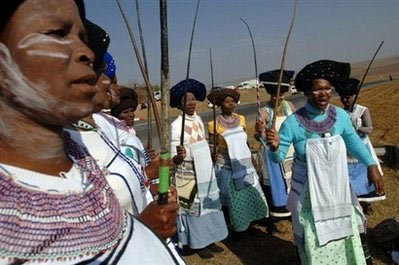AFP
Aug 25, 2009
South African fashion designer inspired by her rural roots
AFP
Aug 25, 2009
JOHANNESBURG, Aug 25, 2009 (AFP) - Brought to Africa by German settlers, the humble cotton "isishweshwe" fabric has shrugged off its colonial origins to become a symbol of urban Afro wear in South Africa.
 Photo: AFP/File/Lionel Healing |
Long associated with newly wed brides and older women, designer Bongiwe Walaza has taken the distinct repetitive patterns in shades of indigo, brown and reds to countries from the United States to Japan and Switzerland.
Inspired by growing up in the rural Eastern Cape -- an impoverished region of breathtaking scenery and thatched mud hut villages that gave birth to Nelson Mandela -- tradition runs strongly through Walaza's collections.
But she has left the fabric's old-fashioned connotations behind, creating a style that has resonated in South Africa's relatively new, post-apartheid democracy.
The result is puffy-shouldered jackets cinched by wide waistbands, mermaid-tailed layered skirts, summery 1950s-style dresses and highly tailored reinventions of the traditional regalia of the Xhosa tribe.
"In the past if you wore a traditional outfit in the city, you were considered backwards and uneducated," Walaza told AFP. "I wanted to change that perception.
"I want to maintain an African look, without excluding anyone who is not African."
According to Da Gamma textiles, the company that produces the fabric -- which is also known as amaJamani in South Africa -- isishweshwe arrived in the country with German Protestant settlers in the mid-19th century.
But although the print was originally targeted at whites it was not long before it crossed over to the market for local black women, who gradually replaced animal skins with newly available cotton garments.
"The challenge as a designer is to take something that people don't usually take seriously and turn it into something that people will stand up and take notice," said Walaza.
"People now even want wedding dresses that are African inspired instead of the Western white wedding dress."
With South Africa entering its first recession in 17 years in 2009, the fallout has been felt by the local fashion industry -- but then business has always been tough, Walaza says.
Designers have to compete with basic needs in a developing country where around two out of five people live on two dollars a day, and a retail-savvy black middle class has only recently emerged.
"The recession has made things worse but I know designers have always battled with a lot things that need to be addressed. For me it's nothing new for designers to struggle," said Walaza.
"Designer clothes are not on the majority of people's mind, they are concerned with shelter, food and transport."
The local industry is also not established.
"There are many design schools and many design graduates, but most of them won't survive as fashion designers. They would have to find something else.
"That is why if a person wants to be in this industry they must make sure they have the passion."by Tabelo Timse
Copyright © 2024 AFP. All rights reserved. All information displayed in this section (dispatches, photographs, logos) are protected by intellectual property rights owned by Agence France-Presse. As a consequence you may not copy, reproduce, modify, transmit, publish, display or in any way commercially exploit any of the contents of this section without the prior written consent of Agence France-Presses.

























